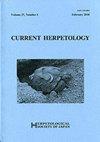Diet Composition of the Invasive American Bullfrog (Lithobates catesbeianus) in Onuma Quasi-National Park, Hokkaido, Japan
IF 0.7
4区 生物学
Q4 ZOOLOGY
引用次数: 4
Abstract
Abstract: An invasive alien species American bullfrog (hereafter, ‘bullfrog') is found in freshwater lakes in Onuma Quasi-National Park, Hokkaido, Japan. Bullfrog commonly feeds on red swamp crayfish in many areas. However, red swamp crayfish has not been confirmed in Komuna Lake, Onuma Quasi-National Park. The purpose of this study is to examine the trend of predation on native biomes in areas without crayfish presence. We detected the dietary composition of bullfrogs. The stomach contents of 469 individuals were analyzed and classified. The stomach contents of adult frogs accounted for 67.4% of volume were vertebrates including Actinopterygii and Amphibia such as Japanese crucian carp, topmouth gudgeon, bullfrog juveniles, bullfrog tadpoles and Japanese common toad. Further, aquatic animals were preyed more than terrestrial animals in volume (60.0%) and frequency (90.0%). From these results, bullfrogs in Onuma Quasi-National Park used most conspicuous alien aquatic species such as alien fish and frogs of the same species as food resources and further revealed that these alien aquatic species function as a substitute food for the crayfish. While the majority of bullfrog food resources are alien aquatic species, several rare aquatic animals were also preyed on. In the future, it will be necessary to investigate the predation pressure of bullfrogs on local biodiversity.日本北海道大沼准国家公园入侵美洲牛蛙的饮食组成
摘要:在日本北海道大沼准国家公园的淡水湖中发现了一种外来入侵物种美国牛蛙(以下简称“牛蛙”)。在许多地区,牛蛙通常以红色沼泽小龙虾为食。然而,在小沼准国家公园的科穆纳湖,红色沼泽小龙虾尚未得到证实。本研究的目的是研究在没有小龙虾存在的地区,对本地生物群落的捕食趋势。我们检测了牛蛙的饮食成分。对469名患者的胃内容物进行了分析和分类。成年蛙的胃内容物占体积的67.4%,是包括放线菌目和两栖纲在内的脊椎动物,如日本鲫鱼、乌鱼、牛蛙幼体、牛蛙蝌蚪和日本蟾蜍。此外,在数量(60.0%)和频率(90.0%)上,水生动物比陆生动物被捕食更多。从这些结果来看,大沼准国家公园的牛蛙使用了最显著的外来水生物种,如外来鱼类和同类青蛙作为食物资源,并进一步揭示了这些外来水生物种作为小龙虾的替代食物的作用。虽然牛蛙的食物资源大多是外来水生物种,但也有几种罕见的水生动物被捕食。未来,有必要调查牛蛙对当地生物多样性的捕食压力。
本文章由计算机程序翻译,如有差异,请以英文原文为准。
求助全文
约1分钟内获得全文
求助全文
来源期刊

Current Herpetology
Agricultural and Biological Sciences-Animal Science and Zoology
CiteScore
1.20
自引率
14.30%
发文量
20
期刊介绍:
Current Herpetology publishes original research articles on amphibians and reptiles. It is the official journal of the Herpetological Society of Japan and is a continuation of Acta Herpetologica Japonica (1964–1971) and Japanese Journal of Herpetology (1972-1999).
 求助内容:
求助内容: 应助结果提醒方式:
应助结果提醒方式:


